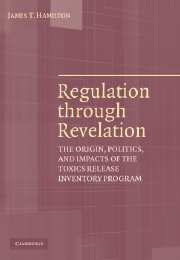 Regulation through Revelation
Regulation through Revelation Book contents
- Frontmatter
- Contents
- Acknowledgments
- Introduction
- 1 Legislating an Incomplete Contract
- 2 Defining Terms: Rulemaking and the Initial TRI Data Release
- 3 Spreading the Word in the Public and Private Sectors
- 4 Politics of Expansion and Contraction
- 5 Life Cycles in the Regulatory Environment
- 6 The Impact(s) of the TRI
- 7 Lessons from and for Regulatory Implementation
- Notes
- Bibliography
- Index
3 - Spreading the Word in the Public and Private Sectors
Published online by Cambridge University Press: 24 November 2009
- Frontmatter
- Contents
- Acknowledgments
- Introduction
- 1 Legislating an Incomplete Contract
- 2 Defining Terms: Rulemaking and the Initial TRI Data Release
- 3 Spreading the Word in the Public and Private Sectors
- 4 Politics of Expansion and Contraction
- 5 Life Cycles in the Regulatory Environment
- 6 The Impact(s) of the TRI
- 7 Lessons from and for Regulatory Implementation
- Notes
- Bibliography
- Index
Summary
The operation of the Toxics Release Inventory program in its early years (1987–1992) involved a cast of thousands – thousands of manufacturing firm employees who filled out thousands of forms describing chemical releases and transfers at thousands of plants. Although the TRI Form Rs provided a detailed picture of toxics emitted in a given community, if members of the public heard anything at all about the program, the news often came in the form of stories about national or state reports produced by the EPA or environmental groups. Reports based on the yearly release of TRI figures became a way for the EPA to chart the progress of the program and for interest groups to highlight both the dangers posed by chemical exposures and the shortcomings involved in the production or interpretation of the pollution data.
In September 1990 the EPA released the second annual TRI report, which contained the agency's analysis of 1988 TRI data. The headline to many was that total TRI releases and transfers had dropped from 7 billion pounds in 1987 to 6.2 billion pounds in 1988. In the first page of the report, however, the agency noted that the 11% decline in reported figures did not translate into an 11% reduction in actual emissions:
While some of the decrease in TRI totals is due to actual reductions in the quantity of wastes generated or disposed of, much of the apparent decline between 1987 and 1988 stems from “paper” changes, that is, from changes in how wastes were estimated or reported, rather than changes in waste generation practices. […]
- Type
- Chapter
- Information
- Regulation through RevelationThe Origin, Politics, and Impacts of the Toxics Release Inventory Program, pp. 75 - 115Publisher: Cambridge University PressPrint publication year: 2005


